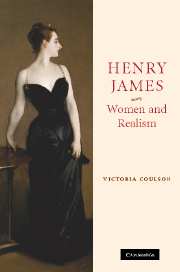Book contents
- Frontmatter
- Contents
- Acknowledgements
- List of abbreviations
- Introduction: ambivalent realism
- Chapter 1 Alice James and the portrait heroine
- Chapter 2 The actress and the orphan: Henry James's art of loss, 1882–1895
- Chapter 3 Teacups and love letters: Constance Fenimore Woolson and Henry James
- Chapter 4 Realism and interior design: Edith Wharton and Henry James
- Epilogue: 1892
- Notes
- Bibliography
- Index
Introduction: ambivalent realism
Published online by Cambridge University Press: 22 September 2009
- Frontmatter
- Contents
- Acknowledgements
- List of abbreviations
- Introduction: ambivalent realism
- Chapter 1 Alice James and the portrait heroine
- Chapter 2 The actress and the orphan: Henry James's art of loss, 1882–1895
- Chapter 3 Teacups and love letters: Constance Fenimore Woolson and Henry James
- Chapter 4 Realism and interior design: Edith Wharton and Henry James
- Epilogue: 1892
- Notes
- Bibliography
- Index
Summary
I am grieved to hear that Mrs Stoddard is ill; why do literary women break down so, and … act so? It almost seems as though only the unhappy women took to writing. The happiest women I have known belonged to two classes; the devoted wives and mothers, and the successful flirts, whether married or single; such women never write.
(Constance Fenimore Woolson to E. C. Stedman [1876?])The novel is the only developing genre and therefore it reflects more deeply, more essentially, more sensitively and rapidly, reality itself in the process of its unfolding.
(Mikhail Bakhtin, ‘Epic and Novel’)RESTIVE CONSERVATIVES
This book explores the structural interdependence of writing, gender and cultural authority within a small, yet suggestively representative, group of late nineteenth-century expatriate American writers. It focuses on the textually mediated relationships between Henry James (1843–1916) and three of his most important female friends: his sister Alice (1850–92), career hysteric and author of a significant diary, and the novelists Constance Fenimore Woolson (1840–94) and Edith Wharton(1862–1937). At the heart of this book is the claim that the distinctively ambivalent private, professional and literary lives of Henry James, Alice James, Constance Fenimore Woolson and Edith Wharton adumbrate the contours of inarticulate discontent within a conservative but increasingly restive, and beleaguered, cultural establishment.
From the middle of the nineteenth century, both in Britain and the United States, the ‘Woman Question’ was a central focus of debate.
- Type
- Chapter
- Information
- Henry James, Women and Realism , pp. 1 - 24Publisher: Cambridge University PressPrint publication year: 2007



